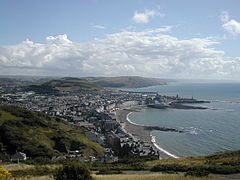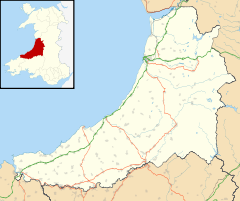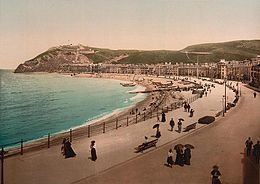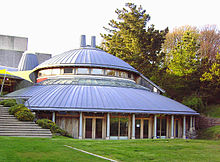
Aberystwyth
About this schools Wikipedia selection
This Wikipedia selection is available offline from SOS Children for distribution in the developing world. A quick link for child sponsorship is http://www.sponsor-a-child.org.uk/
Coordinates: 52.414°N 4.081°W
| Aberystwyth | |
 View of Aberystwyth |
|
|
|
|
| Population | 15,935 (2001) |
|---|---|
| OS grid reference | SN585815 |
| - Cardiff | 90 mi (140 km) SE |
| Principal area | Ceredigion |
| Ceremonial county | Dyfed |
| Country | Wales |
| Sovereign state | United Kingdom |
| Post town | ABERYSTWYTH |
| Postcode district | SY23 |
| Dialling code | 01970 |
| Police | Dyfed-Powys |
| Fire | Mid and West Wales |
| Ambulance | Welsh |
| EU Parliament | Wales |
| UK Parliament | Ceredigion |
| Welsh Assembly | Ceredigion |
|
|
Aberystwyth (English: Mouth of the Ystwyth, / ˌ æ b ə ˈ r ɪ s t w ɪ θ /, Welsh: [abɛrˈəstʊɨθ]) is a historic market town, administrative centre and holiday resort within Ceredigion, Wales. Often colloquially known as Aber, it is located near the confluence of the rivers Ystwyth and Rheidol.
Since the late 19th century, Aberystwyth has also been a major Welsh educational centre, with the establishment of a university college there in 1872. At the 2001 census, the town's population was 15,935. During nine months of the year, there is an influx of students—to a total number of 10,400 as of September 2012—but there is no reliable measure of the number of those students whose family residence is outside Aberystwyth.
Geography
The town is situated near the confluence of the rivers Ystwyth and Rheidol, on the west coast of Wales. Although the name may seem to suggest otherwise, only the River Rheidol passes through the town; following the reconstruction of the harbour, the River Ystwyth skirts the town.
Aberystwyth has a pier and a fine seafront which stretches from Constitution Hill at the north end of the Promenade to the mouth of the harbour at the south, taking in two separate beach stretches divided by the castle. Today it is essentially made up by a number of different areas: Aberystwyth town, Llanbadarn Fawr, Waunfawr, Penparcau, Llanbadarn and Trefechan, with Penparcau being the most populous.
Aberystwyth is an isolated town, considering the population density of the United Kingdom. The nearest substantial settlements are located at least 1 hour 45 minutes' drive away: Swansea, to the south, is 70 miles (110 km) away; Shrewsbury, in Shropshire, England, to the east, is 75 miles (120 km) away; and Wrexham, to the north-east, is approximately 80 miles (130 km) away. The Welsh capital, Cardiff, is over 100 miles (160 km) away. London is 210 miles (340 km) distant from Aberystwyth.
Climate
Aberystwyth experiences an oceanic climate ( Köppen climate classification Cfb) similar to almost all of the United Kingdom. This is particularly pronounced due to its west coast location facing the Irish Sea. Air undergoes little land moderation and so temperatures closely reflect the sea temperature when winds are coming from the predominant onshore (westerly) direction. The nearest Met Office weather station is Gogerddan, 3 miles to the northeast, and at a similar elevation.
The absolute maximum temperature is 34.6 °C (94.3 °F), set during July 2006. This is also the July record maximum for all of Wales, suggesting that the area's low lying situation, aided by a possible fohn effect when winds are offshore can act to achieve high temperatures on occasion. Typically the warmest day will average 28.0 °C (82.4 °F) and 5.6 days will achieve a maximum of 25.1 °C (77.2 °F) or above.
The absolute minimum temperature is −13.5 °C (7.7 °F), set in January 2010. Typically 39.8 days will register an air frost.
Rainfall averages 1112mm a year, with over 1mm recorded on 161 days. All averages refer to the 1971–2000 period.
| Climate data for Gogerddan, elevation 31m, 1971–2000, extremes 1960– | |||||||||||||
|---|---|---|---|---|---|---|---|---|---|---|---|---|---|
| Month | Jan | Feb | Mar | Apr | May | Jun | Jul | Aug | Sep | Oct | Nov | Dec | Year |
| Record high °C (°F) | 16.1 (61) |
17.8 (64) |
22.8 (73) |
26.2 (79.2) |
27.5 (81.5) |
31.7 (89.1) |
34.6 (94.3) |
32.8 (91) |
31.1 (88) |
23.9 (75) |
18.1 (64.6) |
15.5 (59.9) |
34.6 (94.3) |
| Average high °C (°F) | 7.8 (46) |
8.0 (46.4) |
9.6 (49.3) |
11.9 (53.4) |
15.2 (59.4) |
17.3 (63.1) |
19.3 (66.7) |
19.2 (66.6) |
16.9 (62.4) |
13.9 (57) |
10.5 (50.9) |
8.7 (47.7) |
13.19 (55.74) |
| Average low °C (°F) | 2.2 (36) |
2.2 (36) |
3.4 (38.1) |
4.2 (39.6) |
6.8 (44.2) |
9.7 (49.5) |
12.0 (53.6) |
11.8 (53.2) |
9.8 (49.6) |
7.4 (45.3) |
4.4 (39.9) |
2.8 (37) |
6.39 (43.5) |
| Record low °C (°F) | −13.5 (7.7) |
−11.1 (12) |
−9.4 (15.1) |
−5.1 (22.8) |
−2.6 (27.3) |
0.6 (33.1) |
2.8 (37) |
2.8 (37) |
0.0 (32) |
−4.3 (24.3) |
−11.9 (10.6) |
−12.4 (9.7) |
−13.5 (7.7) |
| Precipitation mm (inches) | 103.47 (4.0736) |
77.65 (3.0571) |
88.91 (3.5004) |
61.47 (2.4201) |
60.58 (2.385) |
77.57 (3.0539) |
74.91 (2.9492) |
93.65 (3.687) |
98.59 (3.8815) |
121.02 (4.7646) |
122.63 (4.828) |
121.22 (4.7724) |
1,112.84 (43.8126) |
| Source: KNMI | |||||||||||||
Physical features
Aberystwyth is a major tourist centre and a cultural link between North Wales and South Wales. Constitution Hill is scaled by the Aberystwyth Electric Cliff Railway giving access to fine views and other attractions at the top, while much of the finest scenery in Mid Wales lies within easy reach of the town. This includes the wilderness of the Cambrian Mountains, whose valleys contain forests and meadows which have changed little in centuries. A convenient way of reaching the interior is by the preserved narrow gauge Vale of Rheidol Railway.
Although the town is relatively modern, it contains a number of historic buildings, including the remains of the castle and the Old College of Aberystwyth University nearby. The Old College was originally built and opened in 1865 as a hotel but, due to the bankruptcy of the owner, the shell of the building was sold to the university in 1867. The new university campus overlooks Aberystwyth from Penglais Hill to the east of the town centre. The terminus for the standard-gauge railway is also very impressive, having been built in 1924 in the typical style of the period. Generally, the architecture is a mix of Gothic, Classical Revival and Victorian.
The town is generally regarded as the capital of Mid Wales and several institutions have regional or national offices there. Perhaps the most important of the public bodies located in Aberystwyth is the National Library of Wales. The library also incorporates the National Screen and Sound Archive of Wales, one of six British regional film archives. The Royal Commission on the Ancient and Historical Monuments of Wales, which maintains and curates the National Monuments Record of Wales (NMRW), providing the public with information about the built heritage of Wales. Aberystwyth is also the home to the national offices of UCAC and Cymdeithas yr Iaith Gymraeg and the site of the Institute of Grassland and Environmental Research. The Welsh Books Council and the offices of the standard historical dictionary of Welsh, Geiriadur Prifysgol Cymru, are also located in Aberystwyth.
History
Mesolithic
There is evidence that during the Mesolithic Age the area of Tan-y-Bwlch at the foot of Pen Dinas ( Penparcau) was used as a flint knapping floor for hunter gatherers making weapons from flint that was deposited as the ice retreated.
Bronze and Iron Ages
The remains of a Celtic fortress on Pen Dinas (or more correctly 'Dinas Maelor'), a hill in Penparcau overlooking Aberystwyth, indicates that the site was inhabited before 700 BC. On a hill south of the present town, across the River Ystwyth, are the remains of a medieval ringfort believed to be the castle from which Princess Nest was abducted. This rare survival is now on private land and can only be accessed by arrangement.
Middle Ages
The recorded history of Aberystwyth may be said to date from the building of a fortress in 1109 by Gilbert Fitz Richard (grandfather of Richard de Clare, known as Strongbow, the Cambro-Norman lord notable for his leading role in the Norman invasion of Ireland). Gilbert Fitz Richard was granted lands and the lordship of Cardigan by Henry I, including Cardigan Castle. The fortress built in Aberystwyth was located about a mile and a half south of today's town, on a hill over the south bank of the Ystwyth River. Edward I replaced Strongbow's castle in 1277, after its destruction by the Welsh. His castle was, however, built in a different location, at the current Castle Hill, the high point of the town. Between the years 1404 and 1408 Aberystwyth Castle was in the hands of Owain Glyndŵr but finally surrendered to Prince Harry (the future King Henry V of England). Shortly after this, the town was incorporated under the title of Ville de Lampadarn (the ancient name of the place being Llanbadarn Gaerog or the fortified Llanbadarn, to distinguish it from Llanbadarn Fawr, the village one mile (1.6 km) inland. It is thus styled in a Royal charter granted by Henry VIII but, by Elizabeth I's time, the town was invariably named Aberystwyth in all documents.
Early modern era
In 1649, Parliamentarian troops razed the castle, so that its remains are now inconsiderable, though portions of three towers still exist. In 1988, an excavation within the castle area revealed a complete male skeleton, deliberately buried. Though skeletons rarely survive in Wales' acidic soil, this skeleton was probably preserved by the addition of lime from the collapsed building. Affectionately known as "Charlie" and now housed in the Ceredigion Museum in the town, he probably dates from the English Civil War period, and is likely to have died during the Parliamentarian siege. His image is featured in one of nine mosaics created to adorn the castle's walls.
Hafod Uchtryd was a mansion built by Thomas Johnes starting in 1783, part of it being designed by John Nash. The landscaped gardens were formed by blasting away parts of hills to create vistas. Roadways and bridges were built and hundreds of thousands of trees were planted. The result was a landscape that became famous and attracted many visitors including Samuel Taylor Coleridge. It is thought to have inspired the passage in his poem Kubla Khan:
And here were gardens bright with sinuous rills,
Where blossomed many an incense-bearing tree;
And here were forests ancient as the hills,
Enfolding sunny spots of greenery.
The house was demolished in 1955 but the landscape remains.
Rural industries and craftsmen were an important part of life in a country town. Information recorded in the local trade directory for 1830 shows that there were in Aberystwyth: Twenty boot makers, eight bakers, two corn millers, eleven carpenters and joiners, one cooper, seven tailors, two dressmakers, two straw hat makers, two hat makers, three curriers, four saddlers, two tinsmiths, six maltsters, two skinners, four tanners, eight stonemasons, one brewer, four lime burners, three shipwrights, three wheelwrights, five cabinet makers, one nail maker, one rope maker and one sail maker.
Victorian era
The Cambrian Railways line from Machynlleth reached Aberystwyth in 1864, closely followed by rail links to Carmarthen, which resulted in the construction of the town's impressive station. The Cambrian line opened on Good Friday 1869, the same day that the new Eugenius Birch designed 292 metres (958 ft) Royal Pier opened, attracting 7,000 visitors.
The railway's arrival gave rise to something of a Victorian tourist boom and the town was once even billed as the "Biarritz of Wales". During this time, a number of hotels and fine townhouses were built including the Queens Hotel. One of the largest of these hotels, "The Castle Hotel", was never completed as a hotel but, following bankruptcy, was sold cheaply to the Welsh National University Committee, a group of people dedicated to the creation of a Welsh University. The University College of Wales (later to become Aberystwyth University) was founded in 1872 in this building.
Aberystwyth was a contributory parliamentary borough until the Third Reform Act, which caused its representation to be merged into that of the county in 1885.
In 1895, various businessmen who had been behind the Aberystwyth New Harbour Company formed the Aberystwyth Improvement Company (AIC) to take over the works of the defunct Bourne Engineering & Electrical. In 1896, the AIC completed three projects: the new landside pavilion for the Royal Pier; built the Cambria Hotel (later the United Theological College) and formed Constitution Hill Ltd, to develop a Victorian theme park. Chief engineer George Croydon Marks designed all the AIC developments, including the United Kingdom's longest funicular railway, which takes passengers up a 50% gradient to a park and camera obscura.
Modern history
On the night of Friday, 14 January 1938, a storm with estimated wind speeds of up to 90 mph (140 km/h) struck the town. Most of the promenade was destroyed, along with 200 feet (61 m) of the pier. Many properties on the seafront were damaged, with every property from the King's Hall north affected, those on Victoria Terrace having suffered the greatest damage. Work commenced on a protective coffer dam until 1940, with total costs of construction coming to £70,000 (equivalent to £2.5 million today).
Cymdeithas yr Iaith Gymraeg held their historic first protest on Trefechan Bridge in Aberystwyth, on 2 February 1963. The first independent Welsh Evangelical Church was established in Aberystwyth (see Evangelical Movement of Wales).
Aberystwyth hosted the National Eisteddfod in 1865, 1916, 1952 and 1992.
On 1 March 2005, Aberystwyth was granted Fairtrade Town status.
In March 2009, mayor Sue Jones-Davies, who had played the role of Judith Iscariot in the film Monty Python's Life of Brian (1979), organised a charity screening of the film. Principal actors Terry Jones and Michael Palin also attended. There is a popular, but incorrect, " urban myth" that the town had banned the film (as some jurisdictions did) when it was first released.
Governance
Aberystwyth Town Council is one of the 51 town and community councils in Ceredigion and consists of 19 town councillors elected in five wards. The last elections were held in May 2012.
Aberystwyth is governed by Ceredigion County Council and Aberystwyth itself elects six of the 42 councillors in five separate wards (Bronglais, Central, North and Rheidol wards elect one councillor each while Penparcau ward elects two). Of the current county councillors, elected in May 2012, four are Plaid Cymru, one is a Welsh Liberal Democrat, and one is an independent.
Aberystwyth has five Welsh Assembly members, one of whom is elected as a constituency AM for Ceredigion, Elin Jones and four who are elected on the regional list for Mid and West Wales.
The town is also within the Ceredigion constituency for elections to the House of Commons. The current MP is Mark Williams for the Welsh Liberal Democrats.
Culture
Arts
Aberystwyth Arts Centre is one of the largest and busiest arts centres in Wales. It encompasses a 312 seat theatre, 900 seat concert hall, 125 seat cinema, and has accompanied studio, galleries, plus public spaces which include cafes and a bar.
Arad Goch is an Arts Council funded community theatre and art gallery based in the town. The premises holds a theatre, gallery, several art studios and meeting rooms, and a darkroom.
Language
The major languages spoken in Aberystwyth are English and Welsh. The 2001 census reported that, in the seven wards of Aberystwyth, 39% of the residents self-identified as either being able to speak, read or write Welsh. This is lower than Ceredigion as a whole (54%) but higher than Wales overall (23%).
Music
Aberystwyth has a live music scene which has produced bands and artists such as:
- The Crocketts
- Hot Puppies
- Murry the Hump
- The Lowland Hundred
The University Music Centre promotes a varied programme for instrumentalists, singers and listeners from the university and the wider community. Also on a Wednesday evening a number of traditional folk music artist congregate in the popular ale drinkers pub, The Ship and Castle.
Sport
Aberystwyth has several sporting associations, including Aberystwyth Athletic Club which was formed in 1955. Aberystwyth RFC is the local rugby union club formed in 1947 and plays in the Welsh Rugby Union leagues.
Aberystwyth Town F.C., formed in 1884, won the Welsh Cup in 1900 before becoming a founder member of the Welsh Premier League (then League of Wales) in 1992. The club last reached the Welsh Cup final in the 2008-2009 season. The town is rich in football with the University of Wales F.C., Penparcau, Bow Street, and Penrhyncoch as well as ATFC Reserves playing in the third tier of Welsh football: Spar Mid Wales League.
Aberystwyth Cricket Club have three senior teams and have been playing in the town in one form or the other since the 1830s. A new Penparcau Boxing Club has been built in Penparcau.
Education
Schools
Aberystwyth has two comprehensive schools serving the town and a wide rural area, namely Ysgol Gyfun Gymunedol Penweddig and Penglais School. The former uses Welsh as the primary language of tuition, the latter, English.
Aberystwyth University
Aberystwyth is home to Aberystwyth University whose predecessor, University College Wales, was founded in 1872 and renamed 'the University of Wales, Aberystwyth' in the mid-1990s. Prior to the college's establishment, Wales had very limited academic-degree capability through St David's College, Lampeter (founded in 1822 but, since 2010, has become amalgamated with Trinity University College, Carmarthen to become 'the University of Wales, Trinity Saint David' with campuses in Carmarthen and Lampeter).
National Library Of Wales
The National Library of Wales, Aberystwyth, is the national legal deposit library of Wales. Established in 1907, it is a Welsh Government sponsored body. According to Cyril Evans, the library's centenary events co-ordinator, "The library is considered to be one of the world's greatest libraries, and its international reputation is certainly something that all Welsh men and women are intensely ... proud of". Welsh is the main medium of communication within the organisation; it aims to deliver all public services in Welsh and English.
Tourism and local economy
As well as having two cinemas and a golf course, the town's attractions include:
- The Aberystwyth Cliff Railway a funicular railway
- A Victorian Camera obscura at the top of Constitution Hill.
- The Vale of Rheidol steam railway (The narrow-gauge Vale of Rheidol Railway)
- Aberystwyth Arts Centre.
- The Parc Penglais nature reserve
- The Ystwyth Trail cycle path
- National Library of Wales
The all organic dairy unit of Rachel's Organic is based in Glan yr Afon, and is the largest private sector employer in Aberystwyth. But many comment that due to its isolated nature, Aberystwyth has developed its own micro-economy: while Rachel's employs 130, new Welsh Assembly offices will employ 1000; the local low-pay sector is dominated by students from the university.
The Cambrian News newspaper came to Aberystwyth from Bala in 1870, after it was purchased by Sir John Gibson. Printed in Oswestry, in May 1880 the paper integrated operations in a former Malthouse in Mill Street. Owned by the Read family from 1926, in 1993 printing was contracted out, enabling the move of editorial staff to the current open-plan offices on Llanbadarn Fawr Science Park. On the death of Henry Read, the paper was purchased by Sir Ray Tindle in 1999, whose company owns more than 200 weekly newspapers in Britain. Now printed in tabloid format, Cambrian News is the second largest weekly-print circulation newspaper in Wales, with 24,000 copies in six regional editorial versions, read by 60,000 weekly readers. The circulation area of mid, west and north Wales covers 3,000 square miles (7,800 km2).
Transport
Rail
Aberystwyth is served by Aberystwyth station, situated in the town centre. The station is the terminus of a service provided by Arriva Trains Wales, on a two-hourly basis (most trains leave at half-past the odd-numbered hours), over the scenic Cambrian Line to Shrewsbury and Birmingham via Machynlleth and Mid Wales. Connecting services from Machynlleth also provide a link to Gwynedd's west coast as far as Pwllheli. There is no longer a southbound link to Carmarthen via Lampeter, this line having fallen victim to the Beeching Axe in 1965.
Aberystwyth station is also the terminus of the Vale of Rheidol Railway, a steam operated narrow gauge heritage railway. Constructed between 1901 and 1902, it was intended to ship mineral cargo, primarily lead, from Devil's Bridge down to Aberystwyth for trans-shipment. By the time it was finished, lead mining was in a deep downturn and, thanks to the Aberystwyth Improvement Company, it therefore came to rely largely on the tourist industry, opening for passengers in December 1902. It still remains open for the summer season, offering a journey of 12 miles (19 km).
In 1896, the Aberystwyth Improvement Company formed Constitution Hill Ltd which, under the direction of chief engineer George Croydon Marks, developed the United Kingdom's then longest funicular railway, the Aberystwyth Cliff Railway, which takes passengers up a 50% gradient.
Road
Two of Wales's important trunk roads, the A487 and A44, meet in the town, with much traffic between north and south-west Wales passing through. The B4574 mountain road linking the town to Rhayader is described by the AA as one of the ten most scenic drives in the world.
Aberystwyth is also a hub for Wales's TrawsCambria bus network. Regular direct services were provided under this network to Bangor, Cardigan and Carmarthen, along with occasional trips to Cardiff. However the direct Cardigan service is no longer regular (reduced to 6 trips per day, with no services between 09:10 and 16:05) and the Carmarthen/Cardiff services have been removed from the TrawsCambria network and rebranded CymruExpress. A daily National Express coach to London and Birmingham also exists.
Notable people
- See Category:People from Aberystwyth
Twinned towns
Aberystwyth is twinned with:








